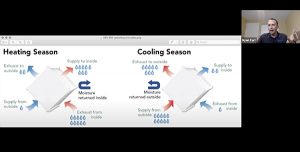
HRVs and ERVs Explained
August 25, 2021 | By Logan Caswell
A recent HPAC Magazine webinar discusses the role of mechanical ventilation systems in buildings and shares some best practices for contractors.

Panelist Ryan Carr explains the principles behind the operations of an ERV core which benefits indoor humidity control in buildings.
The latest instalment of HPAC Magazine’s 30 Mechanical Minutes focused on ventilation, with regular HPAC writer Ian McTeer joined by Ryan Carr, Business Development and Technical Lead with Air Solutions. The main topics of discussion centered around heat and energy recovery ventilation systems (HRVs and ERVs). The episode was sponsored by TSI Inc.
HRV, ERV Basics
Carr explained how modern homes are unlike our grandparent’s drafty houses, and as buildings are no longer constructed to leak heat and moisture they need ventilation of some kind to filter and refresh the stale inside air.
“In our quest for energy efficiency we have tightened up that [building] envelope and we no longer have that natural heat exchange,” said Carr. “So we have to give the house lungs.”
A heat recovery ventilator (HRV) uses the heat in the outgoing stale exhaust air to preheat the incoming air. However, Carr explained that as envelopes have become even tighter, “It’s less about the heat loss/heat gain anymore, and more about the moisture.”
That’s why energy recovery ventilation systems (ERVs) have become more prominent. Not only is the sensible heat addressed, but the system also captures the latent heat (or the moisture) in the air. That means seasonally, in colder climates such as Canada, an ERV transfers the humidity from the air which has been conditioned indoors to the incoming cold bone-dry air and also keeps it at an ambient temperature. While in humid hot weather months excess humidity is kept outdoors. This creates a better indoor environment and ultimately energy savings for the consumer.
Sizing units
In most new residential installations, a simple bedroom count is generally all that’s needed to calculate what size of HRV or ERV unit should be installed.
“Frankly, we don’t really care about square footage,” said Carr. “Because bedrooms are a good indicator of the number of occupants in the house, as they are the ones needing the fresh air.” Carr went on to say contractors can now right-size equipment with a typical three-bedroom family home only needing a 64 cubic feet/minute (cfm) unit for continuous ventilation.
On the commercial building side, McTeer pointed out how the multitude of applications from swimming pools to restaurants and office spaces to gymnasiums complicated the whole process of ventilating a building. The recent pandemic, which drove workers away from commercial buildings to work from home, has highlighted the need to create a healthier environment the workplace.
“Often you hear the term sick building syndrome,” said McTeer. “A lot of it has to do with the fact commercial buildings are very poorly or sometimes overly ventilated to the point where the relative humidity drops to under 10% in some cases. This causes people a lot of grief.” He referred to a recent article about those working from home because of COVID are delighted because their allergies, stuffy nose and dry skin issues have been reduced and they don’t want to go back to the office.
Installation practices
Carr outlined three dominant installation methods for HRV/ERV systems:
Simplified – where the unit is hung in the mechanical room and air is inducted in and out of the return air ducts.
Exhaust ducted – the unit is pulling from high moisture areas of concern—laundry room, bathrooms, and kitchens.
Fully ducted – in this installation method dedicated exhaust ports in those areas of high humidity are combined with supply ducts into common areas such as hallways, bedrooms and family rooms. Eventually the air reaches an equilibrium throughout the building.
Best practices
It is crucial these systems are balanced when installed: too much supply versus exhaust could drive moisture into the walls. “As that moisture moves its way into the outside of that wall it’s going to get cooler, and it may condense inside that wall. It can lead to mold, mildew or rot,” said Carr. Conversely, too much negative air pressure will lead to infiltration of unconditioned air which also increases the risks of mold and higher energy costs. There is also a potential of back draft from combustion appliances, chattering dampers and hard-to-open doors.
Maintenance requirements
Installing an ERV or HRV is an opportunity for service contractors to add another line to the invoice for annual maintenance. Services include cleaning or replacing prefilters, ensuring the condensate line is clear (HRVs), and checking exterior hoods.
View the entire episode of 30 Mechanical Minutes here:




